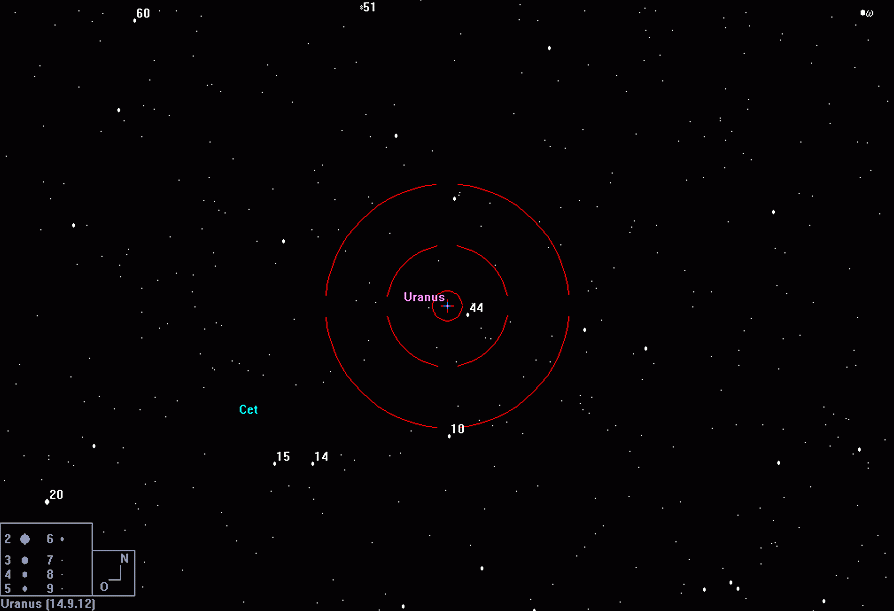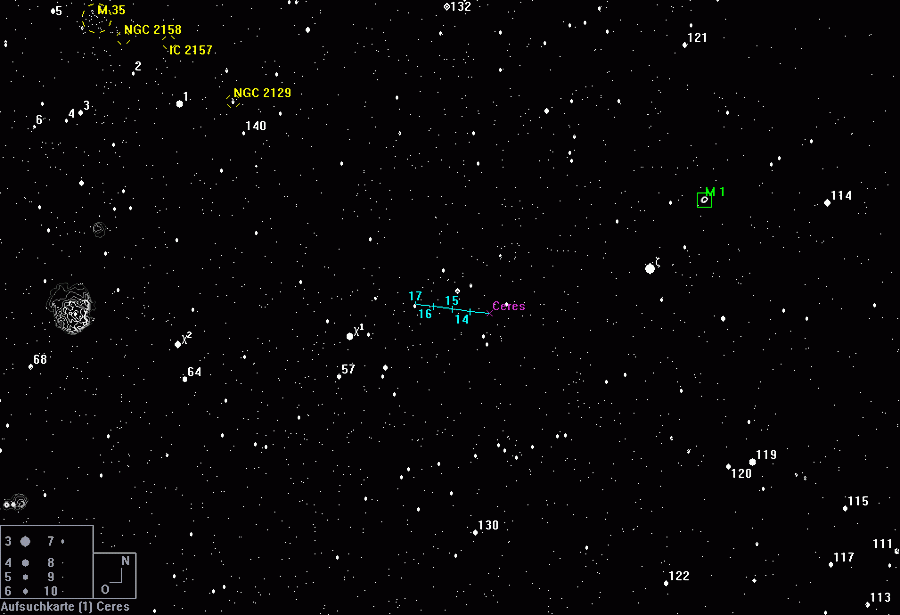Jupiter
|
This year the giant planet Jupiter is located in the constellation taurus. With an apparent brightness of 2.4mag,
it is the most striking object in the sky in the second half of the night (before venus is rising on the eastern
horizon).
Jupiter will reach opposition not until December 03, 2012, but can be observed at the 13.HTT very well: rising
approximately 22:40 o'clock CEST.
A lot of visitors still remember the very good seeing at the last 12.HTT, and also at this year's HTT it will
be worth observing the giant planet with his four brightest moons!
Transit oft he GRF (System II) through the central meridian
- all times in CEST (MESZ):
13.09.2012 01:40
15.09.2012 03:19
15.09.2012 23:10
Jupiter moon - events::
15.09.2012 00:06 III BA
15.09.2012 01:57 III BE
15.09.2012 05:46 I VA
16.09.2012 02:58 I SA
16.09.2012 04:18 I DA
16.09.2012 05:07 I SE
BA + BE: begin + end of eclipse of the moon through Jupiter
VA + VE: begin + end of darkening of moon through Jupiter
SA + SE: begin + end of visibility of the moon-shadow on Jupiter
DA + DE: begin + end of transit of the moon in front of Jupiter
|

|
|
September 16th, 04:18 o'clock CEST:
'entry ' + shadow cast of Io on Jupiter:
|

|
The second picture from left shows Jupiter on early Sunday morning, September 16., 2012 04:19 o'clock CEST at
the beginning of transit of its innermost Galilean moon Io. During transit of this active volcanic moon one can
clearly observe its reddish coloration in front of Jupiters bright clouds.
The left most picture with the Great Red Spot(GRS) shows what is visible in the Jupiter-atmosphere with an
average scope of only 6" aperture(152mm) and good optics (!).
Especially at the 12.HTT(2011) on friday night with very good seeing - see
→
SuW-article from Jan Hattenbach [in German] - kone could compare the optical
quality of the individual instruments, because nearly every visitor observed the roman god-father at culmination-time
through his eyepiece.
The right most picture shows the ecliptic route of Jupiter from Sep. 2011 till Sep. 2012.
|
Uranus
|
The planet Uranus reaches opposition at Sep. 29., 2012 in the constellation pisces. With a brightness of 5.7mag
and the good 'Jessnigk' sky you can see it with the naked eye. Because of near opposition the blue-green planet
is visible over the whole night and at 2 o'clock MESZ in the morning it reaches a culmination height of 40
degrees above the horizon. In a scope you can see only a 3.6" wide disc. Atmospheric details are hardly visible
in the scope, with very steady air, >=12" aperture and a camcorder one can detect large structures! The
visual+photographic hunt for his moons in middle-size/large-size instruments is also very interesting. At the
following finding chart you can find the planet 21' northeast of the 5.8mag star 44 Psc:
|

|
The position of Uranus on Sep. 14th. 2012, 00:00 o'clock UTC (=02:00 o'clock MESZ/CEST in constellation pisces. In
this night, Uranus rises at 19:47 o'clock MESZ and is in culmination at 02:01 o'clock at an altitude of 40.4
degrees. The rising and culmination times decrease 4 minutes per day - this time-shift is almost entirely caused by
earth motion, because the slow own-motion of the outer planets Uranus+Neptun compared to our planet only plays a
minor role.
→
inverted chart.
|
Neptun
|
The outermost member (after degrading Pluto as dwarf-planet) of our planetary system stood in opposition to the
sun last month and now travels retrograde through the constellation Aquarius. The 7.8mag bright planet with an
apparent size of 2.5" can be observed over the whole night and reaches a height of 27 degrees on the meridian at
astronomical midnight(01:00 o'clock MESZ). It gets closer to the star 38 Aquarii(5.5mag), which can be used as
finding aid.
In a scope one can only observe a tiny, structureless disc with greenish color. In larger instruments you can hunt
for his largest moon Triton(~14mag):
|

|
Neptun in the constellation aquarius - on Sep. 14th 2012, 00:00 UTC (=02:00 MESZ/CEST). The chart contains stars
down to 9.5mag, north is top, east is left. Neptun raises on 13.09. at 18:45 o'clock MESZ, on 15.09. at
18:37 MESZ (daily difference 4 minutes, see Uranus)
→
inverted chart.
|
(1) Ceres
|
|
The 970km diameter dwarf planet (1) Ceres can be observed starting one hour after midnight in direction east. At
this time he is already 15? above the horizon between the stars Zeta Tau (2.9mag) and Chi1 Ori (4.4mag) and
culminates in the late morning dawn:
|

|
Ceres-path in the sky from Sep. 13th. - Sep. 17th. 2012 (each 00:00 UTC) at the border of the constellations
Taurus and Orion (stars down to 10.5mag, north is top, east is left). Near Ceres you can find Vesta and
Messier 1 (!) see following sections. →
inverted chart.
|
(4) Vesta
|
|
The planetoid Vesta, which was discovered as fourth planetoid, is located at the north-west corner of the open
star cluster Collinder 65 in the constellation taurus and with an apparent brightness of 8.5mag you can observe
it - like Ceres - with binoculars. It is located in the same region like Ceres, near crab nebula(M1). It can be
found after midnight over the eastern horizon and can be observed till morning dawn:
|

|
The position of Vesta(4) in Taurus from Sep.13. - Sep. 17. 2012 at 00:00 o'clock UTC (stars down to 10.5mag, north is
top, east is left).
→
inverted chart.
|
(2) Pallas
|
The planetoid Pallas (2) nearly reaches opposition on Sep. 25. and is travelling through the nordwest region of
the constellation 'the whale' aka cetus, and with an apparent brightness of 8.5mag, it can already be observed
with small scopes and binoculars almost the whole night. It is located approximately 1 degree southeast of 5.7mag
bright star 12Cet and culminates around 02:00 o'clock MESZ/CEST (one hour after astronomical midnight) at a
height of more than 30 degrees:
|

|
Positions of (2) Pallas in 'the whale'/cetus from Sep. 13th - Sep. 17th 2012 at 00:00 o'clock UTC (stars down to
10.5 mag, north is top, east is left).
On Sep. 14th. 2012 Pallas approaches the faint 12.7 mag galaxy NGC 145
→
inverted chart.
Coordinates (00:00 o'clock UTC = 02:00 o'clock MESZ/CEST ephemeris time):
---------------------------------------------------
RA
Dekl
---------------------------------------------------
15. 09. 0h 30' - 05° 15'
|
LINEAR C/2011 F1
|
Unfortunately, there is no bright "HTT-comet" during our star-party. Though short after the dusk you can observe
C/2011 F1 (LINEAR) in the southeast region of the constellation Bootes.
With a brightness of 10.5-11 mag he is visible in scopes of medium apertures. At the
beginning of the night you can find C/2011 F1 18? above western horizon and he is visible approximately 1 hour
before he set. The chart below shows C/1011 F1 approximately 3.5? southeast of Zeta Bootes (4.5mag):
|

|
The path of LINEAR C/2011 F1 in constellation Bootes - Sep. 13 -Sep. 16. 2012 at 20:00 UTC (stars down to
10.5mag, north is top, east is left). →
inverted chart
Coordinates (00:00 o'clock UTC = 02:00 o'clock CEST ephemeris time):
---------------------------------------------------
RA
Dekl
---------------------------------------------------
13. 09. 14h 51' 53" + 13° 20' 18"
14. 09. 14h 52' 05" + 12° 54' 18"
15. 09. 14h 53' 20" + 12° 28' 20"
16. 09. 14h 54' 36" + 12° 02' 23"
---------------------------------------------------
More and always actual ephemerides can be found here: →
http://scully.cfa.harvard.edu/... [in English]
|
Following the links to the other sections of the HTT-Skyguide 2012:
→
Zodiacal light bridge + Morning sky
→
DEEP SKY 1 (Overview)
→
DEEP SKY 2 (Details)
... And here back to
→
Skyguide Overview 2012.
|